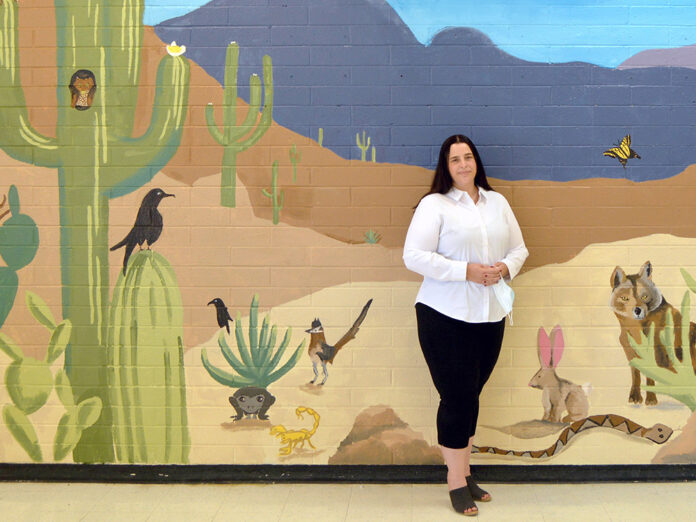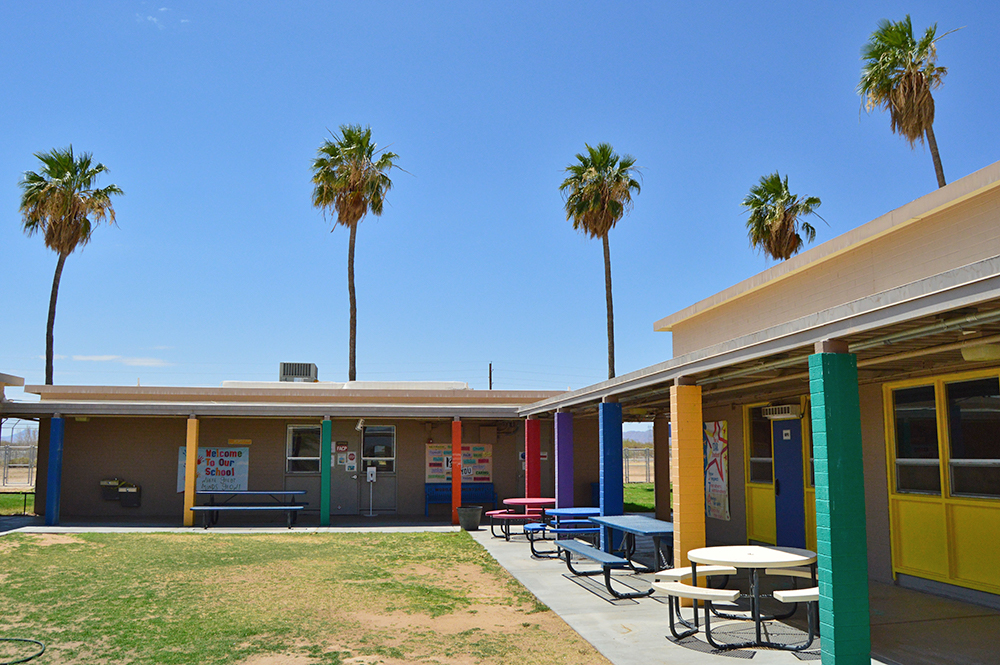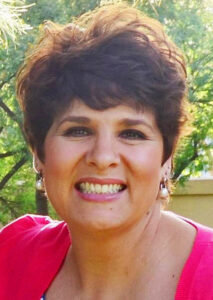
It’s easy to miss the small white building along State Route 238, but there is an interesting
story taking place under the six towering palms at South 99th Avenue.
Mobile Elementary, a public school for students in grades K-8, is unassuming. The facilities are modest — several classrooms, an outdoor activity area and a small administration office — even as its view north to the Sierra Estrella mountains is grand.
Teri Dominguez is superintendent at the Mobile Elementary School District. An elementary and special education teacher for 14 years, she started teaching grades 6-8 at the school in 2010. Four of her children have attended the school and the fifth is a current student. She moved into administration two years ago but continues to function as the school’s special education teacher and school nurse.
“I came here because I loved the difference,” she said. “Where I was before, it was just kind of move them on, move them on. I noticed the difference in culture here. You stop, you care, you work with the kids. That’s why I stayed and that’s why I put my kids in the school, too. I wanted them to be in a school where people did care about them. Not that other schools don’t, I’m sure every school does, but the feeling of it was different, and it was obvious.”
Dominguez has worked to burnish that culture at the school, which is 12 miles west of Maricopa. The blueprint for student success relies on small class size, regular teacher-parent communication and parental involvement, and the staff’s willingness to do whatever it takes for their students.
Class sizes are 12-15 students per multigrade-level class. Since teachers follow their students through several grades, the teachers have the opportunity to learn and build on each student’s individual strengths and learning style. That combined, with innovative curriculum and programming, has led to high levels of student academic achievement.
As a year-round school, students go to classes for 10 weeks then have three weeks off. Students take art, physical education, music, culinary and Spanish. There is a five-week
summer break and summer school is offered to students who need to brush up on a skill or two.
Mobile is a CEP, or Community Eligibility Provision, school, which means it offers breakfast and lunch to students at no charge. Mobile Elementary also runs a food bank through St. Mary’s the first and third Friday of the month. The school provides busing to and from Maricopa, Hidden Valley and Mobile.
Smaller classes make it possible for teachers to monitor their students more closely,
Dominguez said. That enables teachers to spot learning gaps.
“Some students are going to get further behind unless someone cares enough to take
the time and go back and remediate that gap,” she said. “I think that’s what sets us apart. We care. I think we’re special and unique in that way. We work and we find a way to meet those educational needs, whatever they may be.”

‘MORE FOCUSED’
The intense focus on all students has benefited her children, according to one mother.
Tonia Crew, a Maricopa resident since 2011, said her kids have thrived at the school, making the Principal’s List and Honor Roll. Her son Arquavian was just promoted from the school and daughter Aryana will be starting eighth grade when school resumes
July 6 from summer break. They transferred into Mobile Elementary in third and second
grades, respectively.
“They’ve done very well,” Crew said. “They enjoy it. And the small class size contributes to their success. They are more focused with the teacher.”
A smaller student body also allows a level of supervision for teachers to keep tabs on their students’ mental health and ensure a no-bullying culture.
“A lot of parents come here and they’re very happy their students finally have a place that’s safe,” Dominguez said. “They have a place their kids can go and focus on learning, instead of just surviving in that environment.”

Cindy Koontz, a 22-year educator who will be starting her seventh school year, teaches K-2. She said small classrooms do more than just offer personalized, differentiated instruction.
“The multi-age classroom offers children educational exposure to curriculum at multiple
levels, ensuring all children access to learning at their level and ability,” she said. “Students also blossom socially and develop friendships over many grade levels within one classroom.”
The quality and dedication of teachers and staff is perhaps the biggest difference from some other schools, she added.
“One of my philosophies is you hire people who care about kids, who care about the school,
who care about what happens to the kids after they leave here,” Dominguez said. “How
they’re doing in the community, how they’re doing mental health-wise and academically.”
‘A BEAUTIFUL ENVIRONMENT’
During the height of the pandemic, teachers never stopped teaching a regular school day
in their classrooms, live-streaming lessons to students at home. The school provided laptops, cameras and hotspots to families without internet, she said. To make sure all of her students could tune in daily, Dominguez visited homes to troubleshoot technology problems.
When she became superintendent, Dominguez instituted weekly communication between teachers and parents to provide updates on their children’s progress. “It was especially valuable during COVID with children off-campus and more communication needed,” she said.
Teachers and administration also have regular meetings to talk about individual students and their challenges, and share successful classroom strategies.
“Most parents appreciate that the teachers take the time and care about their students,”
Dominguez said. “We’re keeping parents abreast on their progress toward meeting their
goals and grades. I think it helps to get parents and students and teachers on the same page.”
And while that quality education already occurs in modest surroundings, the school is
making improvements even as it prepares for a population boom in the coming years — in
a new location. Residential development in the area is expected to accelerate with the
construction of I-11, a new interstate that, as proposed, will run right through the school
property.
As the population grows, the school will likely need to expand in that new location, perhaps in one of the new residential communities nearby, according to Dominguez. But the superintendent doesn’t expect a bit of expansion to diminish the flourishing
small-school culture treasured by parents and staff.
“We have phenomenal parent and community participation in all our activities and it’s really beautiful. It’s a very community family feel that I’ve never seen anywhere else,”
she said. “That’s one of the reasons why I moved my kids here and why I stayed, because
it’s unique. It’s just a beautiful environment for kids to grow in. It always has been, and I want to keep it that way.
TERI DOMINGUEZ
Occupation: Superintendent, Mobile Elementary School District
Maricopan since: 2010
Family: Five children — four sons and one daughter
Hobby: A home improvement buff, she has renovated a kitchen — top to bottom — and is currently working on a full overhaul of a bathroom. “It was fun, a learning experience because you have to learn — you have to read, go on YouTube, find out how to do it — and then you just do it. I make a lot of mistakes and have to go back and correct them, but you just keep trying and eventually it comes out.
This story appears in the July issue of InMaricopa magazine.

![Maricopa restauranteur makes Food Network connection [Namkeen Dhaba]](https://www.inmaricopa.com/wp-content/uploads/2024/04/439456716_377105198650519_7536248579664805896_n-218x150.jpg)









![Maricopa’s ‘TikTok Rizz Party,’ explained One of several flyers for a "TikTok rizz party" is taped to a door in the Maricopa Business Center along Honeycutt Road on April 23, 2024. [Monica D. Spencer]](https://www.inmaricopa.com/wp-content/uploads/2024/04/spencer-042324-tiktok-rizz-party-flyer-web-218x150.jpg)
![Alleged car thief released without charges Phoenix police stop a stolen vehicle on April 20, 2024. [Facebook]](https://www.inmaricopa.com/wp-content/uploads/2024/04/IMG_5040-218x150.jpg)
![Maricopa restauranteur makes Food Network connection [Namkeen Dhaba]](https://www.inmaricopa.com/wp-content/uploads/2024/04/439456716_377105198650519_7536248579664805896_n-100x70.jpg)


